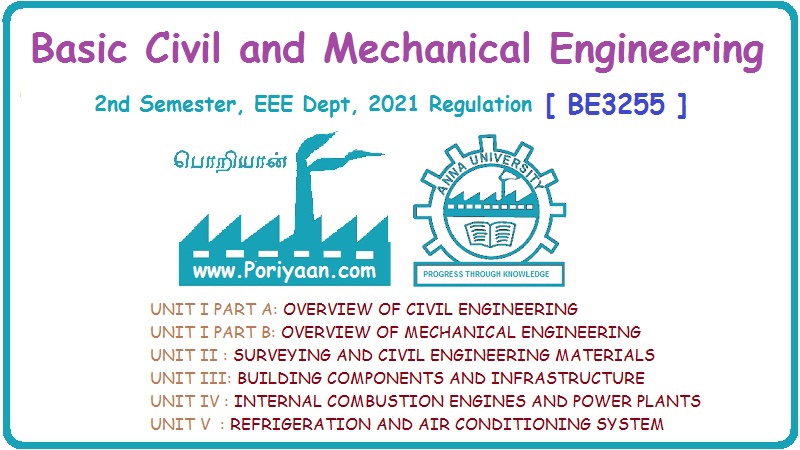Basic Civil & Mechanical Engineering: UNIT I: e. Environmental engineering
Aspects of environmental engineering
The various aspects related to environmental engineering highlighted in Fig. 1 are discussed below:
ASPECTS OF ENVIRONMENTAL ENGINEERING
The
various aspects related to environmental engineering highlighted in Fig. 1 are
discussed below:
Environmental
chemistry
Environmental
chemistry focuses on the presence and impact of chemicals in soil, surface
water, and groundwater. Environmental chemists stüdy how chemicals, usually
contaminants, move through the environment. This is referred to as chemical
“fate and transport”. They also study the effects of these contaminants on
ecosystems, animals, and human health.

Environmental
chemists are involved in the following activities:
(i)
Advise on the movement and outcome of contaminants in soil and groundwater.
(ii)
Assessment of long-term risks to ecological and human health.
(iii)
Applying for environmental permits to undertake corrective strategies.
(iv)
Classifying contaminated soils as hazardous waste
(v)
Managing hazardous waste disposal and supervising onsite remediation.
In
addition to working in the field, they may also conduct laboratory work. For
example, they may analyze chemical interactions or relationships using
chromatography or spectroscopy techniques. They may also take measurements,
interpret data, and use computers to model chemical fate and transport.
Wastewater
Treatment
It
is the process of removing contaminants from wastewater generated by
residential, institutional, commercial and industrial establishments. It
includes household waste liquid from toilets, baths, showers, kitchens, and
sinks draining into sewers.
Physical,
chemical, and biological processes are used to remove contaminants and produce
treated wastewater (or treated effluent) that is safer for the environment. A
by-product of waste water treatment is usually a semi-solid waste or slurry,
called sludge. The sludge has to undergo further treatment before disposal.
The
infrastructure used for wastewater treatment is called a wastewater treatment
plant or a sewage treatment plant in the case of municipal wastewater
(households and small industries). For most cities, the sewer system will also
carry industrial effluent to the treatment plant.
If
the sewer system is a combined sewer, then it will also carry urban runoff
(stormwater) to the treatment plant. Sewage water is taken to treatment plants
through piping and in a flow aided by gravity and pumps. .
The
separation and draining of household waste into greywater and blackwater is
becoming more common in the developed world. Treated greywater is used for
watering plants or recycled for flushing toilets.
Drinking
Water Treatment
Treatment
for drinking water production involves the removal of contaminants from raw
water. The water produced should be pure enough for human consumption without
any short term or long-term risk of any adverse health effect. Substances that
are removed during the treatment process include suspended solids, bacteria,
algae and minerals such as iron and manganese.
Water
Quality Assessment
Water
quality is determined by assessing three classes of attributes: biological,
chemical, and physical. There are standards of water quality set for each of
these three classes of attributes. The national standards for drinking water
are developed by government agencies.
The
drinking water standards are categorized as primary and secondary standards.
Primary standards regulate organic and inorganic chemicals, microbial
pathogens, and radioactive elements that may affect the safety of drinking
water. These standards set a limit, namely, the Maximum Contaminant Level (MCL)
on the highest concentrations of certain chemicals allowed in the drinking
water supplied by a public water system.
Secondary
drinking water standards regulate chloride, color, copper, corrosivity, foaming
agents, iron, manganese, odor, pH, sulfates, total dissolved solids, and zinc.
The above constituents and parameters affect the qualities of drinking water
like taste, odor, color, and appearance. The concentration limit of these
contaminants is referred to as the Secondary Maximum Contaminant Level (SMCL).
State
agencies are responsible for monitoring public water supplies. They enforce the
primary and secondary drinking water standards set by the agencies of
governments.
Environmental
Regulations
Environmental
law, also known as environmental and natural resources law, is a collective
term describing the network of treaties, statutes, common and customary laws
addressing the effects of human activity on the natural environment. The
regulations impose directions on air quality, water quality, waste management,
contaminant cleanup and chemical safety.
Chemical
Risk Assessment
Chemical
risk assessment refers to the identification of hazards, evaluation of their
risks and establishing control measures to secure the health and safety of
employees. It is a major element for managing health and safety under the
Safety, Health and Welfare at Work Act, 2005.
Groundwater
Pollution Control
It
refers to the control of groundwater pollution (also called groundwater
contamination) which occurs when pollutants are released to the ground and
reach groundwater. It can also occur naturally due to the presence of a minor
and unwanted constituent, contaminant or impurity in the groundwater. In the
above case, it is referred to as contamination rather than pollution.
Hazardous
Waste Management
It
refers to the control and management of wastes that has substantial or
potential threats to public health or the environment. Some characteristics of
the hazardous wastes are corrosivity, ignitability, reactivity and toxicity.
Solidwaste
Disposal
The
disposal of solid waste refers to the process of disposing the wastes such that
they no longer possess any harmful threats to the health of human beings and
other living beings. Some of the common solid waste disposal methods are
landfill, incineration and recycling.
Hydrology
Ecosystems (Ecohydrology)
It
is an interdisciplinary field studying the interactions between water and
ecosystems. These interactions may take place within water bodies, such as
rivers and lakes, or on land, in forests, deserts, and other terrestrial
ecosystems. Areas of research in ecohydrology include transpiration (explained
in next chapter) and plant water use, adaption of organisms to their water
environment, influence of vegetation on stream flow and function, and feedbacks
between ecological processes and the hydrological cycle (details presented in
next chapter).
Basic Civil & Mechanical Engineering: UNIT I: e. Environmental engineering : Tag: : - Aspects of environmental engineering
Related Topics
Related Subjects
Basic Civil and Mechanical Engineering
BE3255 2nd Semester 2021 Regulation | 2nd Semester EEE Dept 2021 Regulation
